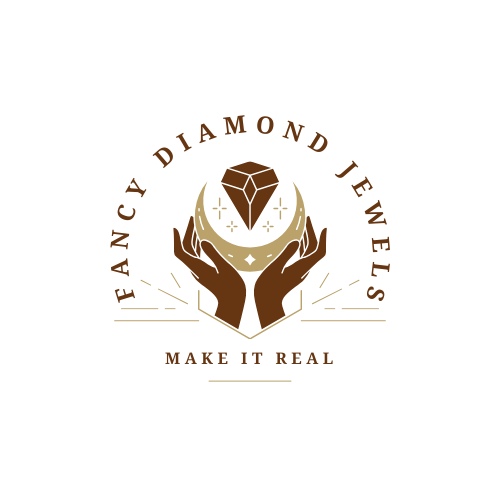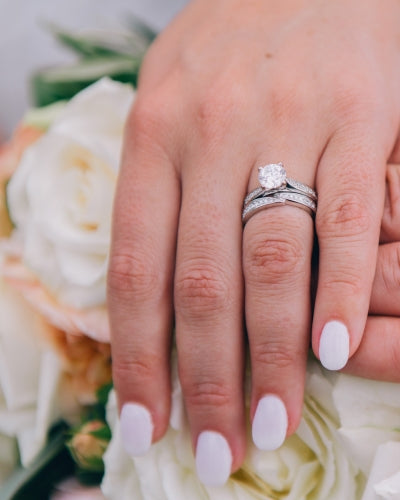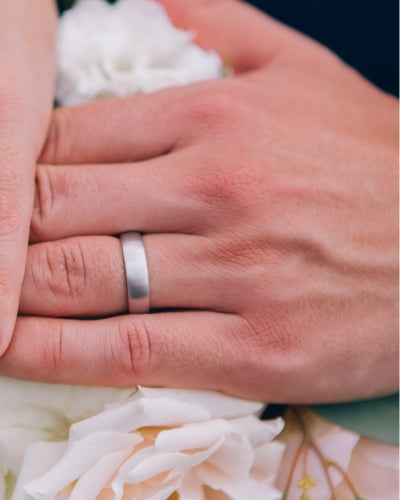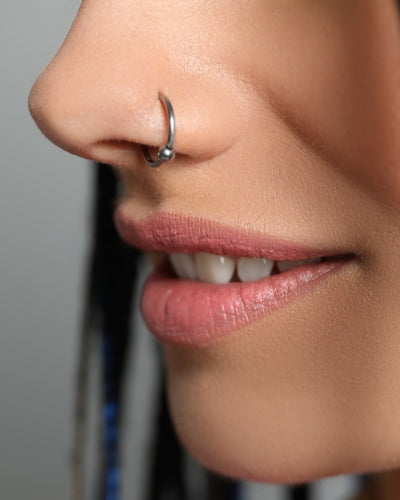
Technical Differences: CVD vs Natural
-
Origin: CVD = lab-grown; Natural = mined over geological timescales.
-
Atomic structure: Identical — both are crystalline carbon (diamond).
-
Trace elements & inclusions: CVD often has different inclusion types and may be easier to reach higher color/clarity grades; naturals can show growth features from their geological history.
-
Detection: Gem labs use spectroscopy and growth-pattern analysis to distinguish lab-grown from natural diamonds.
Implication for earrings
For earrings — where brilliance and symmetry drive visual impact — CVD diamonds can match or exceed the visual performance of natural stones at similar price points because manufacturers can optimize growth for desirable cuts and clarity. This is why many earring collections today feature lab-grown stones in designs from classic studs to modern drops.
See The Link : https://www.fancydiamondjewels.com/collections/diamond-earrings-studs-drop-hoop-earrings
Visual & Optical Comparison
When set and polished to the same cut quality, CVD and natural diamonds are visually indistinguishable to the naked eye in most lighting conditions. The deciding factors for perceived beauty are cut proportions, polish, and setting quality — not origin. High-quality photography and side-by-side in-person inspection remain the best ways to compare sparkle and face-up size.
| Attribute |
CVD Diamond |
Natural Diamond |
| Brilliance |
Comparable when cut well |
Comparable when cut well |
| Inclusions |
Different types; often fewer black inclusions |
Varied; can include unique natural features |
| Color range |
Wide, including treated/color-enhanced options |
Natural color depends on geology; fancy colors rare |
| Price |
Generally lower per carat |
Generally higher |
Price Comparison: Typical Ranges
On average, CVD diamonds retail for a lower price per carat than natural diamonds of comparable cut/color/clarity. Savings can range substantially — buyers often see meaningful price differences that allow upgrades in carat size or setting quality for the same budget. Specific product pages show curated CVD and natural collections so you can compare real SKUs and pricing for studs and drops.
Ethics & Sustainability
Ethical sourcing is a major advantage often cited for lab-grown diamonds: no open-pit mining footprint at the mine site and improved supply chain traceability. Natural diamonds may be sourced responsibly, but mining has a higher immediate environmental and social impact that requires rigorous, verified programs to mitigate. If sustainability is a top priority, CVD is typically the better choice — and many retailers highlight this in their sustainability pages.
Highlight: For buyers who want “ethical luxury” plus the look of a fine diamond earring, CVD options provide a strong combination of value, sustainability and quality.
Certification & How to Verify
Always ask for a gemological report. Reputable labs (IGI, GIA, etc.) indicate whether a stone is lab-grown or natural on the report. For CVD diamonds, look for clear lab-grown designation and details on color/clarity/cut. FancyDiamondJewels product and blog pages include information about certification and how the brand documents origins for each stone.
Checklist when buying
- Request the lab report and check for clear origin declaration.
- Compare face-up photos or request a video under natural light.
- Confirm metal type and earring post/back type for comfort (screw vs friction back).
- Ask about return policies and warranties — especially important for online purchases.
Style Guides: Studs, Drops, Hoops

Design choice has a bigger visual impact than stone origin. Below are styling guides for popular earring types.
Stud Earrings — Everyday Elegance

Studs are all about carat weight, center cut and mounting. With CVD, you can often choose a larger carat for the same budget and still maintain excellent cut quality — perfect for daily-wear studs that read as luxury without the higher natural diamond price-tag. See curated stud selections.
Drop & Dangle Earrings — Drama & Movement

For drops, pairing smaller accent stones with a larger center stone creates high impact. CVD allows creative color pairings (including lab-created fancy colored diamonds) for modern drop styles. Product pages for bead-drop and dangle designs showcase how different stone origins pair with metal finishes.
Hoops & Huggies — Everyday Glam

Micro-pavé CVD diamonds are increasingly used in slim hoops to boost sparkle while keeping costs moderate. Because CVD stones can be produced in controlled sizes, matching stones for pavé is easy, which helps keep symmetry and sparkle consistent.
Care, Maintenance & Insurance
Care is virtually identical: diamonds (CVD or natural) are very hard and durable, but settings, backs and metal wear matter. Routine checks for loose prongs, regular professional cleaning, and proper storage (individual boxes or soft pouches) will keep earrings in showroom shape. Insure high-value pairs regardless of origin. Product care pages and FAQs often detail specific cleaning intervals and recommended jewelers for maintenance.
Pros & Cons — Quick Reference
CVD Diamond Earrings — Pros
- Lower cost per carat, allowing larger or higher-quality stones for the same budget.
- Strong ethical and environmental story for many buyers.
- Consistent availability and easier matching for symmetrical earring sets.
- Wide availability of color-treated and fancy-colored options.
CVD Diamond Earrings — Cons
- Some collectors and buyers place higher emotional value on natural origin.
- Resale market differences — historically natural diamonds have had a more established resale ecosystem.
Natural Diamond Earrings — Pros
- Cultural and historical prestige; many buyers prefer the story of a natural stone.
- Long-established secondary market and traditional appraisal pathways.
Natural Diamond Earrings — Cons
- Higher average price per carat.
- Potential environmental and ethical concerns unless thoroughly vetted.
Case Studies & Real Examples
Below are three short case studies illustrating different buyer profiles and the final choice they made.
Case Study A — The Budget-Conscious Bride
Profile: Wants a pair of classic studs for the wedding and daily wear afterward. Decision: Chose a 1.2 ct total weight CVD stud set with excellent cut, enabling a larger face-up size within budget. Result: Bridal photos with noticeable sparkle, no compromise on setting quality. (See fine stud collection.)
Case Study B — The Heritage Collector
Profile: Collector who prioritizes natural origin and geological provenance. Decision: Selected natural brown/colored diamonds set in 14K rose gold for rare character and historical value. Result: A unique pair that blends geological storytelling with artisanal setting.
Case Study C — The Sustainable Modernist
Profile: Eco-minded buyer building a modern capsule jewelry wardrobe. Decision: Opted for CVD micro-pavé hoops and a matching pendant to keep a cohesive, lower-impact collection. Result: Reduced environmental footprint, cohesive design language and savings reinvested into higher-grade metal and craftsmanship.
Step-by-step Buying Guide (10 steps)
- Set a budget and determine how much you want to spend on stones vs setting.
- Decide finish & metal (14K vs 18K, gold color) for the earring backs and posts.
- Choose between CVD and natural based on priorities: budget, provenance, sustainability.
- Compare lab reports for clarity, color and cut.
- Request close-up photos or videos of the exact pair; evaluate symmetry and polish.
- Confirm return policy and warranty (important for online purchases).
- Ask about resizing/future upgrades if you want to add accent stones later.
- Check shipping insurance and customs for international orders.
- Purchase and have the pair appraised and insured if over a certain threshold.
- Schedule a maintenance check with a trusted jeweler yearly.
Comparison Chart — Quick at-a-glance
| Factor |
CVD |
Natural |
| Price |
Lower (on average) |
Higher (on average) |
| Environmental Impact |
Lower footprint (lab-based) |
Higher (mining footprint varies) |
| Resale |
Emerging market |
Established market |
| Provenance Story |
Modern, tech-forward |
Earth-origin, historical |
Frequently Asked Questions
1. Are CVD diamonds less durable than natural diamonds?
No — both CVD and natural diamonds share the same hardness and are durable in everyday wear. Care depends more on setting and metal quality.
2. Will anyone be able to tell my earrings are lab-grown?
Not to the naked eye in most cases. Only gemological testing can reliably indicate origin; reputable retailers provide lab reports to confirm this.
3. Do CVD diamonds have lower resale value?
Resale dynamics are evolving. Historically, natural diamonds had a more established resale market, but as lab-grown demand grows, resale channels for CVD are expanding.
4. Can CVD diamonds be certified?
Yes. Labs like IGI and others provide certification for lab-grown diamonds indicating cut, color, clarity and that the stone is lab-grown. Always retain the certificate.
5. Are colored CVD diamonds available for earrings?
Yes — CVD processes can produce or be treated to produce fancy colors such as yellow, pink, and blue, enabling bold designer choices.
6. How should I clean diamond earrings?
Use a soft brush with warm water and a mild detergent, rinse thoroughly, and dry on a soft cloth. For delicate pavé settings, professional cleaning is recommended periodically.
7. Should I insure my diamond earrings?
Yes. Insure any high-value jewelry above your comfort threshold — both CVD and natural pieces should be appraised and covered under a jewelry policy.
8. How do I choose between bigger carat (CVD) vs higher quality (natural)?
Decide which visual attribute matters most. If face-up size is the priority, CVD can provide larger stones for the same budget. If natural origin is essential, you may choose a slightly smaller natural stone to stay within budget.
9. Can I get matching wedding sets with CVD diamonds?
Yes —CVD stones are often used in engagement and wedding collections, offering consistent matching for rings, earrings and pendants. See curated wedding collections for matching sets.
10. Where can I see verified product options for both CVD and natural earrings?
Explore curated earring collections and blog pages that compare lab-grown and natural diamonds to view verified product options and pricing. :contentReference[oaicite:21]{index=21}
Infographic & Visual Summary
Infographic placeholder (designer-ready):
Infographic: CVD vs Natural Diamond Earrings comparison














Laisser un commentaire
Ce site est protégé par hCaptcha, et la Politique de confidentialité et les Conditions de service de hCaptcha s’appliquent.